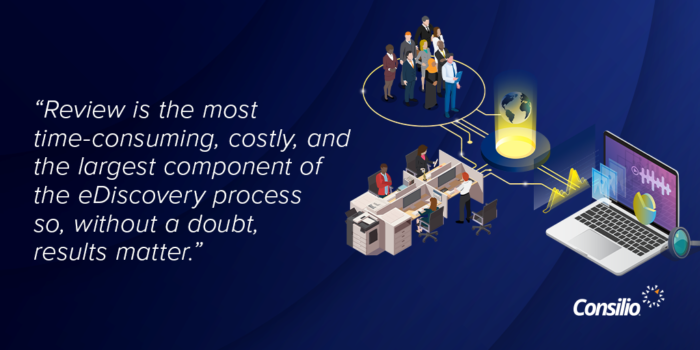Review is the most time-consuming, costly, and the largest component of the eDiscovery process so, without a doubt, results matter. But, larger data sets and more complex data threaten to further inflate these specs. Lack of proper controls and procedures can make the process vulnerable to error and exorbitantly high costs. Whether in the position of producing docs or identifying the opposition’s hot docs, there are several points to keep in mind throughout the review process.
Inefficiencies and Inconsistencies in Review Workproduct
First and foremost, the ultimate goal is to deliver a high-quality document review workproduct quickly and efficiently. Without proper controls, planning, and use of available technology; inefficiencies and inconsistencies may plague the process and final result.
Personnel
1. It is common to assemble an entire document review team on extremely short notice. While this can be a headache in one’s home country, assembling a team on a global level can be inconceivable given the time constraints. In many cases, teams must be able to handle niche, cross-border matters, requiring strong background knowledge and experience characteristic of Subject Matter Experts (SMEs). However, it can be difficult to get SMEs to agree to the review if you have access to any.
2. Once a team is assembled, training and debriefing may be necessary. Greenness has the potential to translate into weakness in the final product. A lack of proper training and clear methods of communication can result in:
- Disorder of dialogue and feedback
- Unclear code preferences
- Conflicting methods of communication and collaboration preferences
- Unapplied knowledge in the area of expertise
Technology and Workflows
Utilizing intelligent workflows and technology are the best ways to streamline the review process while producing an optimal workproduct. This is easier said than done. Outdated technology can impede the process. For example, old versions of document viewers allow users to access only one page at a time, greatly inhibiting the productivity and efficiency of a project.
However, it is possible to extend discovery deadlines in a court of law. That being said, time lags associated with processing data are not recognized as “excusable neglect”. Therefore, it is an absolute necessity to utilize technology capable of returning quick results and discovery.
Technology-Assisted Review (TAR) has long been the industry standard, as analytics provide the best insight on workflows and data. Given the time constraints, a team cannot afford to work without the TAR intelligent workflow insight.
Cost Unpredictability
Transparency in cost structure should be a key consideration in the review process, but it is not unheard of for organizations to be left with a surprisingly hefty bill after all is said and done. Review services can yield exorbitantly high costs as data volume and complexity continue to rise. Traditional cost structures oftentimes do not account for these exponential transformations in data. As a result, cost predictability can be clouded.
Overall, the cost is generally affected by several factors:
- Licensing and risk control procedures
- Hiring, training, and retention
- Mistakes, misinterpretations, and general productivity
- Hardware, software, and space associated with data storage and management
- Data ingestion, enrichment, and extraction
Matter Complexity
Search can hugely complicate the review process if done haphazardly. Redundancy and poor-construction can prove to be efficiency roadblocks during the review process. Duplicates, volume, relevancy are key considerations here. Search term-optimizing measures must be undergone to ensure smooth sailing.
Security and Privacy
Security and privacy are hugely important during the discovery process, and this obviously extends to the document review process. Neglecting this area can result in later sanctions and huge organizational costs later on. Data breaches have become more common present-day and this must be accounted for. Additionally, sensitive PII/PHI will be included in many documents and it is the team’s responsibility to make sure this information does not end up in the opposition’s hands.
What This Means For Your Organization
Without proper controls, document review has the potential to consume vital time and resources. It is your company’s responsibility to take measures to make the process more efficient while boosting productivity and quality.
